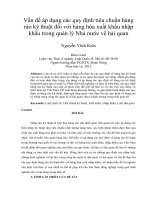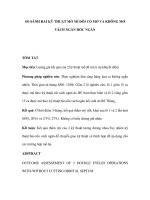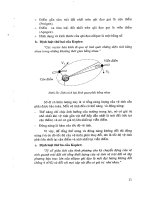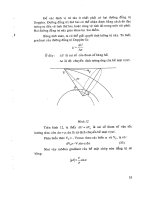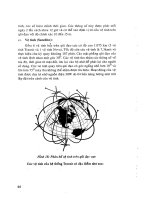mhhf hàng hải kỹ thuật
Bạn đang xem bản rút gọn của tài liệu. Xem và tải ngay bản đầy đủ của tài liệu tại đây (2.99 MB, 12 trang )
<span class='text_page_counter'>(1)</span>GMDSS GUIDE. www.furuno.com.
<span class='text_page_counter'>(2)</span> G G. E E. N N. E E. R R. A A. L L. C C. O O. N N. C C. E E. P P. T T. O O. F F. G G. M M. D D. S S. Global Maritime Distress and Safety System (GMDSS) has been developed by the maritime nations in the International Maritime Organization (IMO) and is the result of their adoption of amendments made in 1988 to the 1974 International Convention on the Safety of Life at Sea (SOLAS). Based on recent developments in maritime communications, such as satellites and digital technology, GMDSS is designed to ensure maximum availability of safety-related communication for all passenger ships as well as for cargo vessels of 300 GT and upwards engaged in international voyages.* The goal of GMDSS is to virtually guarantee that complying vessels will be able to communicate with an onshore station at any time, from any location, in case of distress or to exchange safety-related information. *Ships below 300 gross tonnage as well as those that are not engaged in international voyages are subject to the requirements of the administrations of their flag states.. SEA AREAS GMDSS defines four sea areas based upon the location and capability of onshore-based communication facilities. The definition of the Sea Areas for GMDSS is outlined below. Please refer to the illustrated layout of the European area indicating the sea areas and coastal stations for quick reference. Example: European GMDSS SEA AREAS GMDSS Sea Areas Medium Frequency (MF), High Frequency (HF) and Very High Frequency (VHF) Coast Radio Station Medium Frequency (MF) and Very High Frequency (VHF) Coast Radio Station Very High Frequency (VHF) Coast Radio Station. Sea Area. The radiotelephone coverage of VHF coast stations in which continuous alerting by Digital Selective Calling (DSC) is available.. Sea Area. The radiotelephone coverage of MF coast stations in which continuous alerting by Digital Selective Calling is available.. Sea Area The coverage of Inmarsat geostationary satellites.. Sea Area Area outside A1, A2 and A3, mostly sea area around polar areas 1. S S.
<span class='text_page_counter'>(3)</span> Comparison between old distress system and GMDSS Reliance on ships in vicinity. Worldwide coverage. B e c a u s e o f t h e i n h e re n t ly l i m i te d ra n g e o f transmission on the distress and calling frequencies of 500 and 2182 kHz, which were commonly used for that purpose, there was a possibility that a call for assistance would not be heard if other vessels and coastal stations were outside the range.. G M D S S ve s s e l s c a r r y t h e c o m mu n i c a t i o n s equipment appropriate for the Sea Area they are operating, and have the means to transmit longrange communication whenever necessary. This means that a call for assistance can reach a coastal station, and other ships at a far distance.. Equipment compatibility. It was only possible for a vessel in distress to ask other vessels in the vicinity for assistance, due to the limited range of communication means. Wo rs e , t h e c o m m u n i c a t i o n i n c o m p a t i b i l i t y bet ween a telegraphy vessel and a telephony vessel hindered subsequent Search and Rescue operations.. Since all GMDSS vessels carr y standardized e q u i p m e n t fo r t h e S e a A re a , a n d t h ey a re operating in the same frequencies, the compatibility between the SAR coordinator at a coastal station and a vessel is assured.. Special skill to operate. Simple and automatic operation. Radio officers had to send distress calls in Morse Code on 500 kHz through complicated operations, which include: switching and/or adjusting the transmitters. A successful distress attempt relied heavily on the skill of the radio officers.. GMDSS equipment, on the other hand, provides straightforward operation in time of emergency simply by pressing the distress button on the VHF, MF/HF DSC or Inmarsat MES. If this cannot be done, a float-free EPIRB can transmit a distress alert. 2.
<span class='text_page_counter'>(4)</span> C a r r i a g e/functional requirements for GMDSS General functional requirements for GMDSS 1 Transmission of ship-to-shore distress alerts by at least two separate and independent means, using different radiocommunication service; 2 Reception of shore-to-ship distress alerts; 3 Transmission/reception of ship-to-ship distress alerts; 4 Transmission/reception of search and rescue co-ordinating communications;. 5 Transmission/reception of on-scene communications; 6 Transmission/reception of SART signals for locating; 7 Transmission/reception of maritime safety information; 8 Transmission/reception of general radiocommunications to and from shore-based radio systems or networks; and 9 Transmission/reception of bridge-to-bridge communications.. System suggestions for GMDSS General requirement for equipment and functions for all ships irrespective of the operating sea area Two-way VHF radiotelephone apparatus At least two two-way VHF radiotelephone apparatus required for cargo ships of 300-500 GT At least three two-way VHF radiotelephone apparatus required for all passenger ships and cargo ships of 500 GT and upwards. Search and rescue locating device (SART: either by radar transponder operating in the 9 GHz band or AIS-SART). At least one SART required for cargo ships of 300-500 GT At least two SART required for all passenger ships and cargo ships of 500 GT and upwards. VHF radiotelephone with DSC and DSC Watch Receiver capable of: ◆ Transmission/reception of DSC on CH 70 (156.525 MHz); ◆ Transmission/reception of radiotelephony on CH 6 (156.300 MHz), CH 13 (156.650 MHz) and CH 16 (156.800 MHz); and ◆ Continuous watch on CH 70 (156.525 MHz). Model: FM-8900S. 406 MHz EPIRB International NAVTEX Receiver. (Emergency Position Indicating Radio Beacon). Model: NX-700 Inmarsat EGC receiver Required if the ships operate within Inmarsat coverage but outside the international NAVTEX service area. However, ships operating exclusively in areas where an HF direct-printing telegraphy maritime safety information service is provided and fitted with equipment capable of receiving such service may be exempted from this requirement.. Arrangements required only for all passenger ships Two-way radiotelephone for on-scene search and rescue communication using frequencies 121.5 MHz and 123.1 MHz. A distress panel at the conning position If the satellite EPIRB is used as the secondary means of distress alerting and not remotely activated, it is acceptable to have an additional EPIRB installed close to the conning position.. Model: IC-350 Automatic and continuous update of position for all relevant radiocommunication equipment to be included in the initial distress alert activated through the distress panel. 3. Permanently arranged electrical lighting for illuminating the control panel of the radiocommunications equipment. Automatic provision of position from an internal or external navigation sensor for all twoway communication equipment that includes ship's position in the distress alert.
<span class='text_page_counter'>(5)</span> Additional equipment to be installed on ships operating in the Sea Areas: Note: There is no additional equipment required for ships operating exclusively in the Sea Area A1. MF/HF radiotelephone with built-in DSC/DSC Watch Receiver. Functional requirements to be fulfilled by FS-xx75: ◆ Distress and safety communications on MF (2,187.5 kHz using DSC* and 2,182 kHz using radiotelephony) *It should be possible that transmission of distress alerts be initiated from the navigation bridge.. ◆ Continuous DSC watch on the frequency 2,187.5 kHz ◆ Transmission and reception of general communications using radiotelephony or direct-printing telegraphy**. FS-1575/2575/5075. **For areas where there is no coastal radio station handling MF/HF general communications, Inmarsat-C mobile earth station may be used to fulfill the requirement for general communications.. Other functional requirements. Inmarsat-C Mobile Earth Station. FELCOM18. Transmission of ship-to-shore distress alerts by radio service other than MF (to be fulfilled by 406 MHz satellite EPIRB). Maintenance requirement for ships operating in Sea Area In order to ensure the maintenance requirements specified in SOLAS Reg. IV/15, one of the following measures should be taken as may be approved by the flag administrations:. and DUPLICATION OF EQUIPMENT REQUIRED FOR SHIPS OPERATING IN SEA AREA A1 and A2. • Duplication of equipment; • Shore-based maintenance; or • At sea electronic maintenance capability Please consult with the flag administrations for details.. VHF radiotelephone with built-in DSC/DSC Watch Receiver. FM-8900S. 4.
<span class='text_page_counter'>(6)</span> C a r r i a g e/functional requirements for GMDSS Additional equipment to be installed on ships operating in the Sea Areas:. Inmarsat Solution Inmarsat-C Mobile Earth Station. MF/HF radiotelephone with built-in DSC/DSC Watch Receiver. FS-1575/2575/5075. FELCOM18 Functional requirements to be fulfilled by FELCOM18*:. Functional requirements to be fulfilled by FS-xx75*:. ◆ Transmission and reception of distress and safety communications using direct-printing telegraphy. ◆ Distress and safety communications using the following frequencies: • 2,187.5 kHz using DSC and continuous DSC watch • 2,182 kHz using radiotelephony. ◆ Initiation and reception of distress priority calls ◆ Continuous watch on shore-to-ship distress alerts, incl. those directed to specially defined geographical area. *It should be possible that transmission of distress alerts be initiated from the navigation bridge.. ◆ Transmission and reception of general communications using either radiotelephony or direct printing telegraphy *It should be possible that transmission of distress alerts be initiated from the navigation bridge.. Other functional requirements Initiation of transmission of ship-to-shore distress alerts* to be fulfilled by one of the followings: ◆ 406 MHz satellite EPIRB ◆ HF using DSC ◆ Inmarsat-C Mobile Earth Station *It should be possible that transmission of distress alerts be initiated from the navigation bridge.. OR. MF/HF Solution MF/HF radiotelephone with built-in DSC/DSC Watch Receiver. NBDP Terminal. FS-1575/2575/5075. IB-585. Functional requirements to be fulfilled by FS-xx75* plus IB-585: ◆ Distress and safety communications on all distress and safety frequencies on MF and HF bands using DSC using radiotelephony using direct printing telegraphy ◆ Continuous DSC watch on 2,187.5 kHz, 8,814.5 kHz, and on at least one of the distress and safety frequencies: 4,207.5 kHz, 6,312 kHz, 12,577 kHz or 16,804.5 kHz ◆ Trasnsmission and reception of general radio communications using radiotelephony or direct-printing telegraphy by MF/HF radio installation *It should be possible that transmission of distress alerts be initiated from the navigation bridge. 5. Inmarsat-C Mobile Earth Station. FELCOM18 Functional requirements to be fulfilled by FELCOM18*: ◆ Initiation of the transmission of ship-to-shore distress alert by radio services other than HF *It should be possible that transmission of distress alerts be initiated from the navigation bridge..
<span class='text_page_counter'>(7)</span> Maintenance requirement for ships operating in Sea Area In order to ensure the availability of the maintenance requirements specified in SOLAS Reg. IV/15.7, combination of at least two of the following methods should be taken as may be approved by the flag administrations, while taking into account the recommendation specified in IMO A.702(17): duplication of equipment; • shore-based maintenance; or • at-sea electronic maintenance capability. All ships irrespective of the methods used should make all manufacturers’ installation manuals and maintenance manuals for all the equipment installed available. Adequate tools, spare parts and test equipment appropriate to the methods used by the ship, as specified by the flag administration should be provided and readily available onboard.. Duplication of equipment 1. VHF radio installation capable of transmitting/receiving DSC on CH 70 as well as radiotelephony on CH 6, 13 and 16 as well as contionuous DSC watch on CH 70 and either of the radio installations listed as 2-a or 2-b below should be arranged onboard:. VHF radiotelephone with built-in DSC/DSC Watch Receiver. FM-8900S 2-a. MF/HF radio installation for distress and safety communications on the frequency bands between 1,605 kHz and 4,000 kHz and between 4,000 kHz and 27,500 kHz, using DSC, radiotelephony and directprinting telegraphy. Continuous DSC watch on 2,187.5 kHz, 8,814.5 kHz and on at least one of the distress and safety frequencies: 4,207.5 kHz, 6,312 kHz, 12,577 kHz or 16,804.5 kHz is also required.. 2-b. Inmarsat MES capable of transmission/reception of distress and safety communications using directprinting telegraphy, initiation/reception of distress primary calls, continuous watch on shore-to-ship distress alerts, incl. those directed to specifically defined geographical area, and transmission/reception of general communications using either radiotelephony or direct-printing telegraphy. OR. MF/HF radiotelephone with built-in DSC/DSC Watch Receiver. NBDP Terminal. Inmarsat-C Mobile Earth Station. FS-1575/2575/5075. IB-585. FELCOM18. Shore-based maintenance. At-sea electronic maintenance capability. An arrangement acceptable to the flag administration should be established to ensure adequate support of the ship for the maintenance and repair of the radio installations, i.e., service agreement with a capable service provider covering the trading area of the ship.. Adequate additional technical documentations, tools, spare parts and test equipment consistent with radio installation and as approved by the flag administration should be provided onboard so that the maintainer can perform tests and localize and repair faults in the radio equipment while at sea. The person who is to conduct at-sea electronic maintenance should either hold an appropriate certificate as specified by the Radio Regulations or have equivalent at-sea electronic maintenance qualifications as may be approved by the flag administration, taking into account the recommendation specified in Annex 5 of IMO A.703(17). 6.
<span class='text_page_counter'>(8)</span> C a r r i a g e/functional requirements for GMDSS Additional equipment to be installed on ships operating in the Sea Areas:. MF/HF radiotelephone with built-in DSC/DSC Watch Receiver. NBDP Terminal. FS-1575/2575/5075. IB-585. Functional requirements to be fulfilled by FS-xx75* plus IB-585: ◆ Distress and safety communications on all distress and safety frequencies on MF and HF bands • using DSC • using radiotelephony • using direct printing telegraphy ◆ Continuous DSC watch on 2,187.5 kHz, 8,814.5 kHz, and on at least one of the distress and safety frequencies: 4,207.5 kHz, 6,312 kHz, 12,577 kHz or 16,804.5 kHz ◆ Trasnsmission and reception of general radio communications using radiotelephony or direct-printing telegraphy by MF/HF radio installation *It should be possible that transmission of distress alerts be initiated from the navigation bridge.. Other functional requirements: ◆ Initiation of the transmission of ship-to-shore distress alert by radio services other than HF** **Inmarsat **In ** Inma In mars ma rsat rs at C MES at MES E cannot canno ot satisfy sati sa tisf ti sffy the t e requirement, th requ re quir qu irem ir ement, em ent and en and d this this his shall hi shal sh alll lead al lead ad to to the assumption assu ump pti tion on that on that hat 406 ha 406 MHz MHz MH Satellite EPIRB is the only option available to satisfy the functional requirement.. 7.
<span class='text_page_counter'>(9)</span> Maintenance requirement for ships operating in Sea Area. and. In order to ensure the availability of the maintenance requirements specified in SOLAS Reg. IV/15.7, combination of at least two of the following methods should be taken as may be approved by the flag administrations, while taking into account the recommendation specified in IMO A.702(17): • duplication of equipment; • shore-based maintenance; or • at-sea electronic maintenance capability. All ships irrespective of the methods used should make all manufacturers’ installation manuals and maintenance manuals for all the equipment installed available. Adequate tools, spare parts and test equipment appropriate to the methods used by the ship, as specified by the flag administration should be provided and readily available onboard.. Duplication of equipment 1. VHF radio installation capable of transmitting/receiving DSC on CH 70 as well as radiotelephony on CH 6, 13 and 16 as well as contionuous DSC watch on CH 70, and VHF radiotelephone with built-in DSC/DSC Watch Receiver. FM-8900S 2. MF/HF radio installation for distress and safety communications on the frequency bands between 1,605 kHz and 4,000 kHz and between 4,000 kHz and 27,500 kHz, using DSC, radiotelephony and direct-printing telegraphy. Continuous DSC watch on 2,187.5 kHz, 8,814.5 kHz and on at least one of the distress and safety frequencies: 4,207.5 kHz, 6,312 kHz, 12,577 kHz or 16,804.5 kHz is also required.. MF/HF radiotelephone with built-in DSC/DSC Watch Receiver. FS-1575/2575/5075. NBDP Terminal. IB-585. Shore-based maintenance. At-sea electronic maintenance capability. An arrangement acceptable to the flag administration should be established to ensure adequate support of the ship for the maintenance and repair of the radio installations, i.e., service agreement with a capable service provider covering the trading area of the ship.. Adequate additional technical documentations, tools, spare parts and test equipment consistent with radio installation and as approved by the flag administration should be provided onboard so that the maintainer can perform tests and localize and repair faults in the radio equipment while at sea. The person who is to conduct at-sea electronic maintenance should either hold an appropriate certificate as specified by the Radio Regulations or have equivalent at-sea electronic maintenance qualifications as may be approved by the flag administration, taking into account the recommendation specified in Annex 5 of IMO A.703(17).. Note: For ships operating in the sea area A4 only occasionally but mostly operating in A3, Inmarsat C MES may be installed for duplication in lieu of MF/HF radiotelephone with built-in DSC plus NBDP terminal, provided that the ship has originally MF/HF radio installation.. VHF radiotelephone with built-in DSC/DSC Watch Receiver. Inmarsat-C Mobile Earth Station. FM-8900S. FELCOM18. 8.
<span class='text_page_counter'>(10)</span> FURUNO GMDSS EQUIPMENT F O R R E L I A B L E C O M M U N I C AT I O N. VHF Radiotelephone MODEL: FM-8900S ▲ ▲▲ ▲▲▲ ▲. Semi-duplex 25-Watt radiotelephone with a built-in Class-A DSC and CH70 watch receiver Fully meets GMDSS carriage requirements for SOLAS ships Meets the new ITU reccomendation on digital selective calling system for use in the Maritime Mobile Service, ITU-R M.493-13 Easy to read, high-contrast 4.3" bright color LCD Enhanced noise reduction and speaker for superb voice quality Automatic entry of own ship position and time through the interfaced GPS receiver ATIS signal transmission available for inland waterways. Dual-channel NAVTEX Receiver MODEL: NX-700A (message display and a printer) NX-700B (message display unit only) ▲▲ ▲ ▲ ▲ ▲. Fully meets IMO resolution MSC.148(77), IEC 61097-6 Ed.2 Dual channel reception, 518 kHz and either 490 or 4209.5 kHz, simultaneously Incorporate a printing device (NX-700A) or dedicated display device with printer output (NX-700B) 200 messages of average length 500 characters can be stored in non-volatile memory Incorporates a preamp within a lightweight, compact antenna for reliable, uninterrupted reception Low power consumption. Inmarsat-C Mobile Earth Station MODEL: FELCOM18 ▲ ▲ ▲▲▲ ▲. 9. Inmarsat-C Mobile Earth Station terminal for GMDSS application Full GMDSS compliance with optional printer and AC/DC power supply SSAS capability with SSAS Alert Unit Compatibility with LRIT application A wide variety of communication schemes available: telex, FAX, emailing, EGC, data reporting/polling, etc. SD card for recording media.
<span class='text_page_counter'>(11)</span> MF/HF Radiotelephone. MODELS: FS-1575 (150 W), FS-2575 (250 W), FS-5075 (500 W) ▲▲ ▲ ▲▲. MF/HF radiotelephone with DSC facility Fully meets GMDSS carriage requirements for SOLAS ships operating in A3 and A4 sea areas Meets the new ITU reccomendation on digital selective calling system for use in the Maritime Mobile Service, ITU-R M.493-13 Easy to read, high-contrast 4.3" bright color LCD Capable of distress, safety and routine communication. NBDP Terminal Unit MODEL: IB-585. The IB-585 NBDP terminal facilitates telex communication. File management, text editor and utility programs ensure straightforward operation.. GMDSS Radio Station. MODEL: RC-1800F2. The RC-1800F2 contains all the necessary radio equipment for ships operating in the GMDSS sea areas A1, A2 and A3. The availability of radio communications is assured by the equipment duplication as specified in the previous page. This package delivers the operation scheme that is straightforward in addition to streamlined installation on new builds as well as retrofitting.. ▲▲▲▲▲. The communication equipment within the RC1800F2 includes: Printer for Inmarsat-C Printer for DSC/NBDP Inmarsat-C Mobile Earth Station MF/HF radiotelephone NBDP Terminal. 10.
<span class='text_page_counter'>(12)</span> All brand and product names are registered trademarks, trademarks or service marks of their respective holders. SPECIFICATIONS SUBJECT TO CHANGE WITHOUT NOTICE FURUNO DEUTSCHLAND GmbH. FURUNO HELLAS S.A.. FURUNO SVERIGE AB. FURUNO FRANCE S.A.S.. FURUNO (CYPRUS) LTD. FURUNO FINLAND OY. FURUNO ESPAÑA S.A.. FURUNO EURUS LLC. FURUNO ELECTRIC CO., LTD. FURUNO DANMARK A/S Nishinomiya, Hyogo, Japan www.furuno.com. Hvidovre, Denmark www.furuno.dk. FURUNO U.S.A., INC. FURUNO (UK) LIMITED. Camas, Washington, U.S.A. www.furunousa.com Havant, Hampshire, U.K. www.furuno.co.uk. FURUNO NORGE A/S Ålesund, Norway www.furuno.no. Västra Frölunda, Sweden www.furuno.se Espoo, Finland www.furuno.fi. Rellingen, Germany www.furuno.de. Bordeaux-Mérignac, France www.furuno.fr Madrid, Spain www.furuno.es. FURUNO POLSKA Sp. Z o.o. FURUNO ITALIA S.r.l. Gdynia, Poland www.furuno.pl. Genoa, Italy. Glyfada, Greece www.furuno.gr. Limassol, Cyprus www.furuno.com.cy. FURUNO KOREA CO., LTD. Busan, Korea. RICO (PTE) LTD Singapore www.rico.com.sg. St. Petersburg, Russian Federation www.furuno.com.ru. FURUNO SHANGHAI CO., LTD. Shanghai, China www.furuno.com/cn. 14073SK Printed in Japan Catalogue No. GC-019n.
<span class='text_page_counter'>(13)</span>


